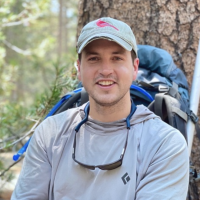GTC Graduate Teaching Community Reflections
Winter 2022
Introduction
Members of the Graduate Teaching Community reflected on the following prompt at the conclusion of the Winter 2022 quarter: How has reading and discussing How Learning Works shaped your current or future teaching practices?
Christine Smudde, Materials Science and Engineering

This quarter, the GTC has raised my awareness of the complexity of learning and increased my understanding of how learning works. Reading and discussing How Learning Works by Susan Ambrose et al. with the Graduate Teaching Community (GTC) was beneficial to my own pedagogy and improvement. First and foremost, I now better understand the intricacies and complexities of the learning process and can adjust my future teaching practices accordingly. Of the many things to consider, I would like to focus on prior knowledge, student motivation, and learning environment.
Prior knowledge can help or hinder learning. Therefore, it is important to recognize the knowledge status of students early on in a course. There are many ways to do this, but the method I found as most useful is a questionnaire or survey at the beginning of a course. I also recognize the value of low stakes homework questions for identifying areas of misinformation or misunderstanding. Inaccurate or insufficient prior knowledge can lead to unnecessary challenges in learning new concepts while accurate and sufficient knowledge can aid in the comprehension of new concepts. Additionally, organizing prior knowledge in a way that is easily accessible and relatable to new concepts is essential. The organization of ideas is something that experts might take for granted. As an expert, I can make connections that are too advanced or are unrecognizable to early learners. Thus, I plan to start using concept maps prior to teaching complicated lessons to understand how the new information can connect to prior knowledge in an efficient and effective manner.
Motivating student learning is important and complicated. Determining what motivates students is important for a productive and effective learning environment. The value placed by students on the course content and their expectancy for success both contribute to motivation. Therefore, showing relevance to current and future lives through purposeful problem selection can aid in the learning process. Additionally, identifying the appropriate level of challenge for the students and articulating expectations for success can help with student expectancy. Alongside a positive learning environment, motivation can beneficially impact learning.
Finally, the environment created by teachers can significantly influence learning, yet creating an environment to facilitate learning is a challenge for a lot of teachers. An important part of creating an inclusive learning environment is to use the syllabus and the first day of class to intentionally establish a positive course climate right away. Also, obvious and planned attempts to include a variety of perspectives and creating opportunities for positive interactions between students will aid in the creation of a positive learning environment. I plan to incorporate the lessons I learned on motivation and environment in my future teaching practices.
Eli Moore, Applied Mathematics

As a graduate student who identifies primarily as an educator, this text has allowed me to cultivate a newfound appreciation for the skills I have developed as a researcher in my academic lifetime. The evidence-based teaching practices described in this book allow me to view teaching as not only an art, but a science - they resonate deeply with me as a result. As a mathematician, it can be easy to slip into solving a niche problem that may or may not have an immediate impact on the world around me; expanding the scope of my research to include educational practices gives me a stronger sense of purpose and immediacy in my academic career. This is especially true when I apply these research-based principles in my day-to-day teaching. It feels rewarding to learn deeply about teaching and see my students reap the benefits in real time
This quarter, I had the opportunity to be the instructor of record for a Calculus 2 course. Having such frequent interactions with my students while reading this book really allowed me to get an up-close view of which of my teaching practices were in line with the research, and which could use some fine-tuning. Chapters 1 and 2 focused on students’ prior knowledge and their organization of this knowledge. Given the reality that many of my students have had a bad time learning math in recent years due to the pandemic, these aspects of learning required additional support. I knew I would be doing a disservice to my students if I assumed too much prior knowledge, so I constantly made an effort to break down problem steps, review Calc 1 material, and take consistent awkward pauses to see if students were finding the material confusing. It is our job as experts to help students organize their conceptual knowledge, since we often have a better sense of how the concepts they are learning blend together. Whenever we ventured into a new topic that built off of previous knowledge in some way (which is the norm in math), I explicitly stated the relationship between the new topic and the old topic in as many ways as I could.
I found the chapters on motivation and environment to be especially salient. In a previous course I taught, I used class time to primarily lecture, and used office hours to help individual students find motivation and cultivate the belief that they can succeed in learning mathematics. However, I ended up only reaching a handful of students using this method, as it was the same students attending office hours over and over; not to mention, spending 100% of class time lecturing likely did not make my class feel like an environment conducive to learning, reducing motivation. This time around, I made sure to sprinkle in many active-learning activities (jigsaws, think-pair shares, and group practice exams + gallery walks), and the culture in the classroom was night-and-day different. I heard tons of laughs, thorough explanations, and a variety of perspectives that were a phenomenal supplement to the ones I presented in class. My students seemed to appreciate the course content more than usual as a result!
Lastly, I found that the discussion surrounding feedback in the book changed my view for future classes. Throughout my course and conversation with students, I learned that many students do not tend to go back and look at solutions to exams, homeworks, etc. We discussed ideas such as regrading and/or giving points for finding typos in solutions, which I think are motivating ways to get students to seek additional feedback (beyond the personalized feedback on their work). Peer feedback from groups is also invaluable, as it does not take away from the admittedly limited number of hours we can give as instructors. I definitely plan to give my students additional feedback opportunities such as these in the future!
Bryan Currinder, Ecology

“Based on years of study and work, you are an expert in your field — but you are certainly not an expert in how to teach others about your field.” How Learning Works
Despite their frequent entanglement in graduate school, research and teaching often require vastly different skillsets and knowledge bases. Graduate programs are typically very good at preparing graduate students to carry out research and scholarship in their respective fields, but often seem less prepared to train graduate students on how to implement effective classroom teaching. Given this common structural deficit, graduate students must seek out teaching resources that offer evidence-based but uncomplicated guidance on how to be effective, inclusive, and efficient in classroom settings.
How Learning Works serves as one potential bridge between subject matter expertise and effective pedagogy. The book outlines an accessible and pragmatic framework of seven key principles that drive student learning, with evidence-based classroom recommendations stemming from each principle. Approaching the book as a pedagogical novice is enlightening, but also surprisingly metacognitive: to learn (1) about how your students learn (2) is to also consider how you currently learn (3) and have learned (4) in past learning (5) environments. As the book outlines directly (though with less semantic satiation), inciting similar metacognitive processes in students can lead to more purposeful and efficient learning as students consider how they best retain and synthesize course material.
Graduate Teaching Community discussions of How Learning Works inspired me to be more direct with students about the why of classroom activities and to explicitly connect classroom activities with specific learning goals. In ecology and environmental science courses, a necessary but challenging goal is to have students synthesize material across knowledge frameworks that are often covered individually in other courses. For example, ecosystems are assembled and maintained by a combination of physical, chemical, and biological factors, each of which interact in complex ways to determine an ecosystem’s structure and function. While these factors often exist as discrete knowledge structures for students, understanding their interactions as an integrated whole is the key to developing course competency. As a Teaching Assistant leading discussion sections, I can directly facilitate synthesis by using activities that enable students to incorporate discrete knowledge frameworks into new ecological contexts, all while explicitly demonstrating that the overall learning goal is synthesis.
Learning is also enhanced through timely feedback, and when students have a model of what success looks like for a specific course goal (e.g. examples of A grade versus C grade assignments). Too often, feedback can feel like a “dead end” for students, especially if connections are not directly made to how the feedback fits into other tasks or larger course goals. In leading future courses, I plan to utilize scaffolded assignments where support is gradually removed, students see models of successful assignments, and feedback is provided to inform the next step of the larger assignment.
As I plan to emphasize teaching beyond graduate school, I strive to move beyond simple subject matter expertise so that my teaching can better reflect the science of learning. Through the diversity of disciplines, backgrounds, and perspectives represented in Graduate Teaching Community discussions, I have begun to bridge this gap.
Chantel Mao, Chemistry

When I first started graduate school, teaching was very intimidating to me. I had no idea what it would be like and the two days of TA training were overwhelming to me. It consisted of teaching us about the teacher-student dynamics, rules to follow, and other logistics. One thing I wish the training focused more on was how to teach in a classroom setting. I remember leading my first discussion and thinking to myself, “Why would these students trust me? I don’t even know what I am doing.” As I started teaching more throughout the quarter, I quickly learned that I love helping my students and seeing them succeed. It is very rewarding to me. After TAing for about three years, I joined the Graduate Teaching Community because I wanted to improve myself as an educator. I wanted to learn more about ways to teach my students effectively. Every week, I looked forward to the GTC meetings because everyone was so welcoming, truly cared about teaching, and offered their advice or perspective on teaching based on the book, How Learning Works.
My goal as a TA has always been to make the students feel welcomed and unafraid to tackle even the most challenging chemistry problems. I want my students to feel comfortable asking me questions, even if they think they are silly, even though most of the time they aren’t because these were things I struggled with as a student. GTC taught me how to explain problems to foster independent thinking, which I found quite valuable. We discussed strategies to provide students ways to reach this goal. I learned that going through problems step by step with the students with notes and describing the steps really helps the students understand what I was doing, then gradually having the students fill in steps in similar problems helps foster an independent thinking environment, which I did implement this quarter. For example, my students would learn how to balance redox reactions. These reactions require numerous steps and differ depending on if it’s in acidic or basic conditions. I would write out each step in words, then work out the problem. After showing these steps in both acidic and basic conditions, they were able to see what it took to work out these problems, making it easier for them to tackle them on their own. It also made the students feel more confident in themselves because they are able to see that the problems are not as complex as they thought they were.
The discussions we had in GTC were both fun and effective in the classroom setting. GTC gave me a new and improved perspective on teaching, something I was missing when I first started teaching three years ago. My passion for teaching has continuously grown throughout this quarter thanks to GTC and the book, How Learning Works. Now, I will continue to implement the strategies we learned throughout the rest of my teaching career and beyond.
Aly Butler, Linguistics

With the winter quarter beginning remotely, I joined the Graduate Teaching Community anticipating we would discuss strategies for teaching on Zoom. The first meeting provided me with numerous tips, including using the waterfall strategy (asking everyone to type their answers into chat and having them all hit “Enter” at once), Google Jamboards, and Zoom polls. When we shifted to in-person classes and began discussing the book How Learning Works, I continued to note down strategies. Chapter 4 titled “How do students develop mastery?” highlights the importance of retrieving students’ component and integration skills when assigning them a new task. I’ve TA-ed for Introduction to Linguistics for two quarters now. The course is organized by introducing one branch of Structural Linguistics and then another, and another, in a way where the students are guided to continually build on their knowledge. For example, the students learn the basics of phonetics (transcription and speech production) before working through a phonology (structure of speech sounds in a language) problem. When I began teaching the vowel chart, I thought that explaining that the schwa is used in an unstressed position (“ago”) and the caret is used in a stressed position (“muddy”) was enough to make clear the difference between the two vowels. I quickly came to realize that some students do not hear stress as well as others. The book helped me understand that, especially in the case of intro courses, a TA would do well to work from the assumption that students are not all starting from the same point. The component skills of identifying stress, reading the vowel chart, and being familiar with the way different vowels sound are all required in order for students to be able to phonetically transcribe American English vowels.
Besides picking up teaching strategies and learning about obstacles students may face in their studies, I have been encouraged to consider my teaching philosophy while reading through How Learning Works. Chapter 5 touches on what some of the other meeting-goers referred to as a “growth mindset.” The chapter looks at the value of practice for students’ mastery of a skill, as well as the kinds of feedback a TA may offer to encourage improvement and initiative. The reading and discussion made me consider the instructors I’ve found to be the most helpful in my own studies. I began my college career in Southeast Europe where there is more of an emphasis on discipline and critique of students’ performance. Having also gone to college in the US, I am aware of the positive reinforcement many instructors here try to practice in their classrooms. The book and teaching community have directed me to a more compassionate and constructive teaching style which I hope to hone in the upcoming quarters.
Ian Lim, Physics

Learning isn't easy. Going from the familiar and the known to the new and uncertain is always a challenging task, and we as teachers always want to ease that passage for our students. In How Learning Works, Susan Ambrose and collaborators have taken on the challenge of unpacking the cognitive principles behind learning through the lens of several common instructional difficulties faced by teachers and the strategies that can help address them. I found many of the chapter-motivating anecdotes extremely familiar, and I was pleased to see that some of my current strategies were supported by the research, while also being inspired by new ideas and approaches.
One concept I'm interested to think about more is how students integrate knowledge to develop mastery. In my introductory physics courses, we often teach concepts to students within the context of individual models but then ask them in our assessments to integrate these concepts in more sophisticated ways involving multiple models, and they often struggle with the latter step. Recognizing that transfer is a skill in itself (and one that needs practice!) makes it clear why this is happening, and in light of this, it might be useful to offer students practice with simply planning their approach to problems and identifying relevant skills.
For example, this quarter I tried incorporating a worked-problem approach where I created a table with three columns. The first column had the generic steps for solving a class of problems, the second had a full solution with those steps applied to a particular example, and the third had the statement but not solution of a different but related example. This way, students could explicitly see the parallels between the worked problem and the new one. I see a lot of potential with these sorts of structured comparisons, though they are somewhat time-consuming to write, and I will continue to experiment with how worked problems and scaffolded problem-solving can help students develop their capacities for skill transfer and integration.
Perhaps one of the most impactful chapters for me was the chapter on how we give and receive feedback. This is often difficult for me to address as a TA—students are often more concerned with their immediate grade than with the feedback itself, so it’s a challenge to provide meaningful feedback at scale. One of my biggest takeaways is that more feedback is not always better, but timely and targeted feedback is often most useful. At scale, this might look like low-stakes or extra credit Canvas quizzes testing basic concepts, with immediate automated feedback to help students review the appropriate material. Using clickers or Zoom polls to gauge where the class is at as a whole is also a strategy I’ve found useful and hope to continue.
Overall, there’s a wide variety of options and opportunities for instructors to build the kinds of structures that support student learning. I’ve definitely deepened my understanding of some of the stumbling blocks faced by instructors and students alike, but when it comes to how learning works, it seems there’s always more to learn.
Kendall Berry, Physics

Sometimes, reading and discussing How Learning Works made me feel like concept maps and rubrics are the solution to every learning problem. But in all seriousness, delving into what the learning process looks like for students has been invaluable as I consider my own future teaching practices. My current goals revolve around two key ideas: Identifying and reinforcing the core purposes of the class, and helping the students build a well-connected and flexible knowledge.
Students' time and cognitive resources are limited, which requires me to identify what really matters in my course and eliminate extraneous material. Then I can break those down into components, and that provides structure for the term. Assignments and tests are designed to target the core goals, as is the feedback. In larger classes, rubrics can help with this. For example, if I'm teaching a class where one of the main principles is conservation of energy, a rubric for a given problem would include categories that highlight the key principles and skills, such as "Identified the applicability of conservation of energy and the relevant types of energy," or "Correctly defined initial and final conditions." When I have a clearer idea of what I want students to take away, I'm better able to communicate it to my students.
Ultimately, I want my students to develop a well-connected knowledge- and skill-base, and to better learn how to learn. Isolated concepts are much more difficult to retain, but if I can help connect them to what students already know, they'll be much more likely to remember it and make later use of it. So throughout the course, I should explicitly relate current material to previous material. This is also where periodic concept maps can be useful for helping students reflect on their own knowledge and for facilitating new connections.
Metacognitive principles (such as assessing the task, planning your approach, evaluating and adjusting strategies) are essentially the same as the problem solving skills I hope my students develop in the physics classes I teach. My goal is to teach course material in such a way that they also develop these skills. Scaffolding can be a powerful way to do this. On early assignments, I can give them general guidelines that can be applied to any quantitative problem. For example, "What is this question asking for? What principles does this rely on? What equations are relevant?" And at the end of the problem, "Does your answer make sense?" Giving examples and targeted feedback will probably be necessary for this to be effective.
I found this book fascinating, and it gave me a number of ideas that I look forward to trying. Incorporating better teaching practices will be a learning process for me as well. I plan to start by implementing only a few at a time. This gives me a chance to evaluate how effective my approach was and to make modifications or add new practices.
And yes, two of those practices will be concept maps and rubrics
